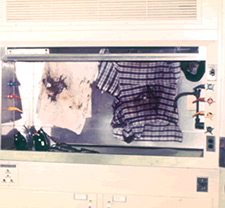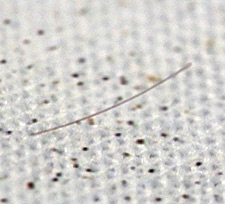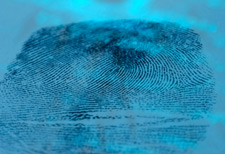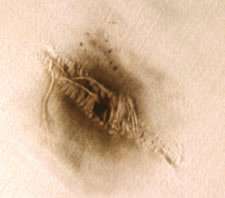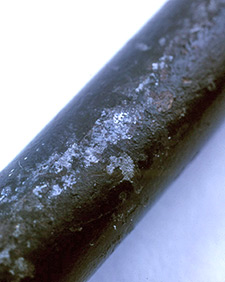Home | Glossary | Resources | Help | Contact Us | Course Map
Archival Notice
This is an archive page that is no longer being updated. It may contain outdated information and links may no longer function as originally intended.
Firearm and Toolmark Examination Considerations
A firearm/toolmark examiners alertness to the possible presence and potential of additional evidence cannot be overstated. When found, its impact on a case can make a significant contribution to an objective and complete laboratory analysis.
Additional examinations may be indicated by the presence of the following evidence:
- Biological
- Trace
- Latent fingerprints
- GSR
- Metal smears
Biological
Victim blood and tissue found on firearm/toolmark-related evidence may associate the evidence with the victim.
Examples of evidence items that may be examined for the recovery of biological evidence:
- Shooting victims garment(s). In some circumstances, it may be desirable to request the performance of DNA analysis prior to gunshot residue analyses. This would be prudent in cases in which the garment is found separate from the body. Gunshot residue examinations performed prior to biological examination may compromise the value of biological evidence for DNA analysis.
- Knife or other tool. Biological evidence from the victim or suspect may be present.
- Muzzle of a firearm. Deposits of biological evidence may be present as a result of a
- Surface of a fired bullet. This is not normally significant if the bullet is recovered during an autopsy; it can be very significant when bullets are found in other parts of a crime scene (e.g., walls, furniture, etc.).
| Biological Evidence on Fired Bullets |
| In a scenario such as the classic drug buy gone bad, guns are drawn and bullets are fired inside a motel room, passing through various victims into walls, bedding, furniture, etc. As a part of the reconstruction, bullets may be related to a particular firearm through the marks they bear. The bullets may also be related to the victims they passed through based on the blood and tissue trace evidence that is carried from the victim. This can be of great assistance to prosecutors in identifying which suspect to charge with which death in this type of free-for-all, Wild West type of shootout. |
Trace Evidence
Firearm/toolmark-related evidence containing small or degraded quantities of DNA were once considered outside the scope of DNA analysis. Since the mid-1990s, mitochondrial DNA (mtDNA) analysis has been used effectively to analyze this type of evidence.
Some examples:
- Bone fragments and teeth occasionally fragments may be observed on fired bullets and bladed instruments.
- Hair may be transferred between individuals and found during microscopic examination of evidence (e.g., when examining a garment for visible gunshot residues). Hair may also be found adhered to or snagged on a firearm or other weapon.
- If a skin tag is attached to the hair, DNA analysis may be performed.
- If the microscopic characteristics of two hair samples are determined to be alike, mtDNA analysis may be done.
- Biological evidence residues on bullets or clothing once considered too small or degraded to analyze can now undergo mtDNA analysis.
Latent Fingerprints
In a small percentage of cases, latent fingerprints are found on firearms. However, due to their value, it may be prudent to examine the firearm for latent prints.
Considerations for firearms-related latent fingerprint evidence include the following:
- Some jurisdictions routinely lift fingerprints at the crime scene to avoid any possibility of obliteration as a result of contact with packaging materials.
- In addition to the exterior of a firearm, the interior should also be examined. The firearm may have been disassembled and the suspects latent fingerprints may be discovered.
- The interior components of a silencer are also a potential location of latent fingerprint evidence. Chemically recoverable latent fingerprints may also be found on the adhesive side of duct tape, which is frequently used for improvised silencers.
- Although rare, it may be possible to recover usable latent fingerprints from the surface of unfired ammunition or fired cartridge cases. This would occur in circumstances where the print was unknowingly rolled over the surface of a cartridge case. This could happen while loading a revolver or the magazine of a firearm.
Gunshot Residue
Gunshot residues are usually within the purview of the firearm examiner. This type of minute residue may be visually apparent; it is most often arrayed as a pattern around a suspected bullet hole. Low power microscopy and chemically specific color-producing tests may be required for detection.
Residue patterns can be reconstructed by firing a series of shots from the suspect firearm and ammunition at varying known distances per laboratory protocol.
Gunshot residue analyses and muzzle-to-target distance determinations are the subject of Module 12.
Read more on Gunshot Residues/Distance Determinations in Module 12.
Metal Smears
This type of trace deposit might be found on the operating surfaces of tools. Metal smears may be observed under the microscope by a toolmark examiner and, if probative in nature, referred to a metallurgist. If a toolmark comparison is inconclusive, these minute deposits could at least be shown to be consistent with a toolmarked surface.
| Note: |
| Examiners should be cautioned that relating a metal smear or other source of metal to a particular source based on a compositional comparison of trace elements present is not a viable option. This approach has been attempted, but all such past comparisons are under increased scrutiny and review. Many laboratories have discontinued the technique. |
Selected Bibliography
The Selected Bibliography is a list of the writings that have been used in the assemblage of the training program and is not a complete record of all the works and sources consulted. It is a compilation of the substance and range of readings and extensive experience of the subject matter experts.
- Federal Bureau of Investigation. Handbook of Forensic Services . https://www.fbi.gov/about-us/lab/handbook-of-forensic-services-pdf
- Fisher, B.A.J. 2003. Techniques of Crime Scene Investigation . Boca Raton: CRC Press.
- Hatcher, J.S. 1947. Hatchers Notebook. 300-333. Harrisburg: Military Service Publishing Co.
- Lee, H.C. 2001. Henry Lee's Crime Scene Handbook . San Diego: Academic Press.
- Saferstein, R. 2006. Criminalistics: An Introduction to Forensic Science , 9th Edition. Upper Saddle River: Prentice Hall.
- Tilstone, W.J., K.A. Savage, and L.A. Clark. 2006. Forensic Science: An Encyclopedia of History, Methods, and Techniques . Santa Barbara: ABC-CLIO.
Additional Online Courses
- What Every First Responding Officer Should Know About DNA Evidence
- Collecting DNA Evidence at Property Crime Scenes
- DNA – A Prosecutor’s Practice Notebook
- Crime Scene and DNA Basics
- Laboratory Safety Programs
- DNA Amplification
- Population Genetics and Statistics
- Non-STR DNA Markers: SNPs, Y-STRs, LCN and mtDNA
- Firearms Examiner Training
- Forensic DNA Education for Law Enforcement Decisionmakers
- What Every Investigator and Evidence Technician Should Know About DNA Evidence
- Principles of Forensic DNA for Officers of the Court
- Law 101: Legal Guide for the Forensic Expert
- Laboratory Orientation and Testing of Body Fluids and Tissues
- DNA Extraction and Quantitation
- STR Data Analysis and Interpretation
- Communication Skills, Report Writing, and Courtroom Testimony
- Español for Law Enforcement
- Amplified DNA Product Separation for Forensic Analysts


